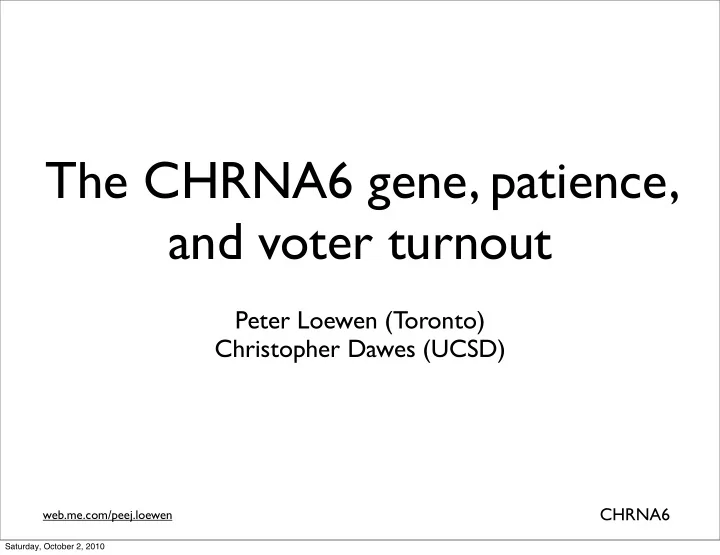

The CHRNA6 gene, patience, and voter turnout Peter Loewen (Toronto) Christopher Dawes (UCSD) CHRNA6 web.me.com/peej.loewen Saturday, October 2, 2010
Road Map • Behaviour genetics, genopolitics • Patience and voter turnout • CHRNB3 and CHRNA6 • Results CHRNA6 web.me.com/peej.loewen Saturday, October 2, 2010
Evidence from twin studies Fowler, Baker and Dawes. 2008. “Genetic Variation in Political Participation.” APSR. CHRNA6 web.me.com/peej.loewen Saturday, October 2, 2010
Evidence from twin studies Cesarini et al. 2008. “Genetic Variation in Preferences for Giving and Risk- Taking.” Quarterly Journal of Economics. Panel A: DG, MZ. Panel B: DG, DZ. Panel C: Risk Aver., MZ Panel D: Risk Aver., DZ CHRNA6 web.me.com/peej.loewen Saturday, October 2, 2010
Evidence from twin studies Cesarini et al. 2008. “Heritability of cooperative behavior in the trust game.” PNAS. CHRNA6 web.me.com/peej.loewen Saturday, October 2, 2010
Evidence from twin studies Loewen and Dawes. “The heritability of duty and voter turnout.” R and R, Political Psychology CHRNA6 web.me.com/peej.loewen Saturday, October 2, 2010
Evidence from gene association studies 14 Change in Likelihoodn of Being a Partisan (%) 12 10 8 6 4 2 0 One Two Number of A2 Alleles Fowler and Dawes. 2008. “Two Genes Predict Voter Turnout.” JOP. Dawes and Fowler. 2009. “Partisanship, Voting, & the Dopamine D2 Receptor Gene.” JOP. CHRNA6 web.me.com/peej.loewen Saturday, October 2, 2010
CHRNA, Patience and Turnout • Patience and turnout • CHRNB3 and CHRNA6 • Results CHRNA6 web.me.com/peej.loewen Saturday, October 2, 2010
The Role of Patience • The traditional calculus of voting does not take account of time. • We vote today, but the benefits come later. • Smaller discount factors should lead to higher turnout. • This applies to expressive voting with equal felicity. CHRNA6 web.me.com/peej.loewen Saturday, October 2, 2010
The Role of Patience Fowler and Kam. 2006. “Patience as a Political Virtue: Delayed Gratification and Turnout.” Political Behavior. CHRNA6 web.me.com/peej.loewen Saturday, October 2, 2010
CHRNA • Nicotine acetycholine receptors (nAChRs) • Implicated in neurotransmission on the sending side. • Two subunits (in CHRNA6 and CHRNB3) influence the release of dopamine. • Dopamine has been related to behaviour in delay discounting tasks (Cui et al 2008) • CHRNA6 and CHRNB3 have been shown to be related to nicotine initiation and dependence (e.g. Lie et al 2005) and alcohol abuse (Hoft et al 2009). • In turn, these behaviours are related to delay discounting behaviour. • Note, finally, the central role of dopamine in regulating (social) behaviour. CHRNA6 web.me.com/peej.loewen Saturday, October 2, 2010
CHRNA Four SNPs CHRNA6: rs2304297 (G) rs892413 (G) CHRNB3: rs4950 (C) rs13280604 (G) CHRNA6 web.me.com/peej.loewen Saturday, October 2, 2010
Data • Add Health • Limited genetic sample • 2574 respondents in the third wave of the study. • 18-26 years old. • Surveyed in 2001 or 2002. • DV: Voting in the 2000 Presidential election. CHRNA6 web.me.com/peej.loewen Saturday, October 2, 2010
Results CHRNA6 web.me.com/peej.loewen Saturday, October 2, 2010
Results 15 Change in Likelihood of Voting (%) 10 5 0 -5 -10 -15 One Two Number of G Alleles CHRNA6 web.me.com/peej.loewen Saturday, October 2, 2010
Replication • 400 adults, principally in California • Imputed SNP , where the measure is the “dosage” of CHRNA6. • Control for age, gender, and ethnicity. Saturday, October 2, 2010
Replication results Saturday, October 2, 2010
Conclusions • Voting may be an act of the patient. • We can link genes to political behaviour through behavioural mediators/mechanisms. • Next steps include risk, trust, inequality aversion, and strategic inference. • Genes are the institutions of the human body. CHRNA6 web.me.com/peej.loewen Saturday, October 2, 2010
Thanks Chris Dawes James Fowler Jaime Settle CHRNA6 web.me.com/peej.loewen Saturday, October 2, 2010
Results CHRNA6 web.me.com/peej.loewen Saturday, October 2, 2010
Recommend
More recommend